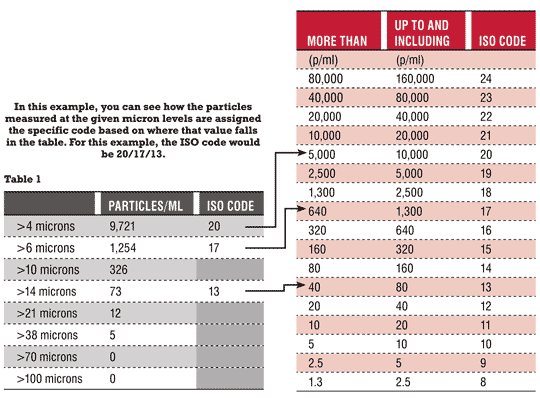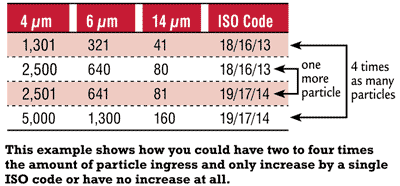How Important is the ISO Cleanliness Code in Oil Analysis?
The International Organization for Standardization (ISO) has developed a cleanliness code that is the primary piece of data reviewed on most industrial oil analysis reports. The value of this code can help determine the overall cleanliness of the monitored system. Often times, an end user will establish a target value to achieve, thus offering a level of confidence so long as the used oil sample meets this established target.
The trend in the oil analysis world is to give too much credit to the value of the ISO cleanliness code. Some laboratories have even begun to only report the ISO code. There is also a heavy reliance on this value by end-user analysts.
The ISO code is a fantastic tool to use for setting target alarms and establishing a goal to achieve and maintain as it relates to system cleanliness. It is also the perfect value to use for key performance indicator (KPI) tracking, charting and posting. However, the ISO code should play only a secondary role when it comes to evaluating used oil sample data.
How the ISO Cleanliness Code is Determined
Most oil analysis samples that receive particle counting are getting what is known as automatic particle counting (APC). The current calibration standard for APC is ISO 11171. When sending a sample through an APC, particles are counted either through laser or pore blockage methods. Although different laboratories may report different particle count micron levels, an example of the various reported micron levels includes those greater than 4, 6, 10, 14, 21, 38, 70 and 100 microns.
ISO 4406:99 is the reporting standard for fluid cleanliness. According to this standard, a code number is assigned to particle count values derived at three different micron levels: greater than 4 microns, greater than 6 microns and greater than 14 microns. The ISO code is assigned based upon Table 1. This can be seen in the example on the left.
However, without seeing the raw data, the only thing the ISO code can positively identify is whether a sample has achieved the desired target value. The ISO code does nothing to help determine any type of real trend information unless the value of the raw data at the given micron levels changes enough to raise or lower the ISO code.

What the ISO Code Can Tell You
It’s easy to look at the ISO table and notice a pattern. At each row, the upper limit for each code is approximately double that of the lower limit for the same code. Likewise, the upper and lower limits are double that of the upper and lower limits of the next lower code. This is known as a Renard’s series table.
The unit of measure for particle count data is “particles per milliliter of sample.” The particle counters used in laboratories incorporate much more than a milliliter of sample. During the testing process, approximately 100 milliliters of sample are taken into the instrument. The numbers of particles are counted based on this value. The total number of particles is then compared to the number of times that 2 will go into that total count exponentially.
| 100 ML | 1 ML | Exponent | More Than (p/ml) | Upto and Including (p/ml) | ISO Code |
|---|---|---|---|---|---|
| 16777216 | 167772.2 | 24 | 80,000 | 160,000 | 24 |
| 8388608 | 83886.08 | 23 | 40,000 | 80,000 | 23 |
| 4194304 | 41943.04 | 22 | 20,000 | 40,000 | 22 |
| 2097152 | 20971.52 | 21 | 10,000 | 20,000 | 21 |
| 1048576 | 10485.76 | 20 | 5,000 | 10,000 | 20 |
| 524288 | 5242.88 | 19 | 2,500 | 5,000 | 19 |
| 262144 | 2621.44 | 18 | 1,300 | 2,500 | 18 |
| 131072 | 1310.72 | 17 | 640 | 1,300 | 17 |
| 65536 | 655.36 | 16 | 320 | 640 | 16 |
| 32768 | 327.68 | 15 | 160 | 320 | 15 |
| 16384 | 163.84 | 14 | 80 | 160 | 14 |
| 8192 | 81.92 | 13 | 40 | 80 | 13 |
| 4096 | 40.96 | 12 | 20 | 40 | 12 |
| 2048 | 20.48 | 11 | 10 | 20 | 11 |
| 1024 | 10.24 | 10 | 5 | 10 | 10 |
| 512 | 5.12 | 9 | 2.5 | 5 | 9 |
| 256 | 2.56 | 8 | 1.3 | 2.5 | 8 |
Staying Clean
Why is cleanliness so important? The answer is simple: competition. In such a globally competitive market where products can potentially be manufactured and shipped from overseas at a lower cost than can be manufactured from here at home, maintaining a precise level of reliability and uptime is necessary to keep costs at a manageable level. Contaminant-free lubricants and components will extend the lifetime of both, and in turn increase the overall reliability of the equipment.
Using the previous example (20/17/13), this means that at the greater than 4 micron level, the number of particles measured was at the most 2^20 and above 2^19. Since particle count data is reported in particles per mL of sample, the raw data must be divided by 100.
While the general rule of thumb is that for every increase in the ISO cleanliness code, the number of particles has doubled, this certainly is not the case in every situation. Because the number of allowable particles actually doubles within each code number, it is possible for the number of particles to increase by a factor of 4 and only increase a single ISO code.
 This becomes a significant problem when you have a target cleanliness level of 19/17/14, your previous sample was 18/16/13, and your most current sample is 19/17/14. For all reporting purposes, you have achieved and maintained the target cleanliness level of 19/17/14. This suggests that your component should be in a “normal” status. Given the information presented previously, it is easy to see how you could have two to four times the amount of particle ingress and only increase by a single ISO code or have no increase at all.
This becomes a significant problem when you have a target cleanliness level of 19/17/14, your previous sample was 18/16/13, and your most current sample is 19/17/14. For all reporting purposes, you have achieved and maintained the target cleanliness level of 19/17/14. This suggests that your component should be in a “normal” status. Given the information presented previously, it is easy to see how you could have two to four times the amount of particle ingress and only increase by a single ISO code or have no increase at all.
The ISO cleanliness code should be used as a target. It is a value that is easily tracked for KPI reporting and a value that most people can easily understand. However, using the ISO cleanliness code for true machine condition support is limited in its effectiveness. The raw data from particle count testing allows the end user to confirm data from other tests such as elemental analysis and ferrous index. The ISO cleanliness code does not allow this cross-confirmation to occur. Reviewing the raw data of the particle counter at all reported levels is absolutely vital in performing quality data analysis on oil sample data.
